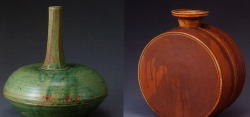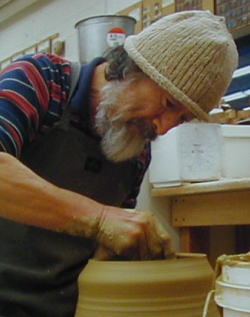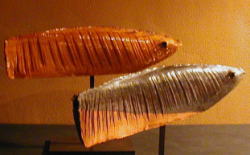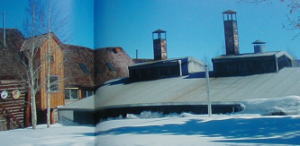I suppose like most fortunate moments in life, we are rarely prepared
or ready when they happen. That was
certainly the case when I first met Takashi Nakazato. At that time I did not know Takashi nor did I have time to
research his pottery. In mid July 1994,
that moment occurred when I was invited to an Aspen dinner party.
As the evening progressed and guests were seated for dinner, it
appeared that the table was one chair short.
I had my dinner on the floor, in front of the fireplace. It was not long before Takashi joined me on
the floor. Takashi’s gracious
personality was evident in our first encounter. It was my sense that maybe he
too felt out of place that evening. It
was not long before John Powers joined us as well.
The first evening together we could barely talk to each other. Plied with wine and a shared love of
pottery, the evening resulted in my extending an invitation to Takashi for a
visit to the Anderson Ranch Arts Center.
Takashi liked what he saw and asked if he could return, I said
“Sure”. With support from John and
Kimiko Powers and others, the Anderson Ranch renovated and winterized a
visiting artist studio and apartment for Takashi’s twice a year visits to
Colorado.
 |
For more than 12 years Takashi has been sharing his wisdom of pottery
and love of life with summer workshop students and studio artists at the Ranch.
His astonishing work habits set the studio pace for everyone to follow. Takashi’s insatiable curiosity would define
the very character of his studio experience.
As an innovator in a century’s old tradition, Takashi would routinely
break the rules. His search is still on
for the elusive thing he has not seen yet.
Takashi commented to me many years ago, “My education is not over”. This is still a true indication of his
commitment to mentoring young artistic minds.
Artistic freedom has always been a hallmark of Takashi’s pottery
career. The Ranch has been his research
and development studio, where unbound by tradition he can explore new
opportunities. His initial seduction was the possibilities of the soda
kiln. Takashi gains strength and
confidence from his innate skills and traditional training, however at the
Ranch he is always open to seeing his work in a different way.
I knew from the beginning, there would be lots to learn from
Takashi. I also realized that asking
many questions was not going to give me any immediate answers, so I watched and
I watched even more. I began to see a
finely tuned set of moves that resulted in cups and bowls and vases flowing
casually from his hands. The ease at which he works seems like magic. Takashi
never seems upset or tired with the clay, or anything else going on around
him. He moves through his pottery like
his life, with grace and appreciation for those around him. In his life and his art, Takashi will try
about anything. He never takes himself
or his pottery too seriously. Takashi
understands the virtue of failure in taking risks for discovery. I once watched in amazement while he
shoveled snow into a red hot kiln to achieve a cooling reduction
atmosphere. And through it all he keeps
on making pots by the hundreds, by the thousands!
 |
Takashi’s pottery and life revel in the pleasures of the everyday world. His pots honor and dignify the
need for daily ritual objects. To use
them and be with them, is to understand Takashi’s pottery. His calculated spontaneity and intentional
immediacy triggers the user to stay engaged.
As the horizons of the Colorado and Karatsu landscape move up and down,
so do the fluid edges and rims of his pottery.
Whether consciously or not, Takashi’s memory honors the places where he
lives and works. Takashi’s relaxed and
loosely controlled working style directs only about 80 percent of his energy to
the clay. The other 20 percent leaves
room for the material and process to have a voice.
Like the natural beauty that surrounds us, Takashi’s pottery compels
you to look and then look again. The
true spirit of his pottery starts with the clay and extends into the form. His
clay choices have always supported a gestural spirit and allowed his technical
skills to flourish. Takashi’s pottery exemplifies grace and balance with an
assuring sense of casual elegance. His
pots reflect familiar images of fruit and flowers. His work is accessible and usable, yet not fragile or elitist.
Strong minded tenacity drives Takashi’s quiet process of discovery. Takashi’s pottery is well made, but not
precise. A bowl is a bowl, never are
two alike.
After one of our early wood firings with Takashi, everyone was admiring
their pieces, while he was systematically breaking all of his. His explanation was short and to the point,
“Too much runny ash”. The discussion
that followed, was an instant art lesson between what are clear intentions and
undesirable results. Takashi's pots
become sedated and obscured when covered with runny wood ash glaze.
He said to me that the runny ash distracts from the beautiful shapes and
forms of his pottery. The other part of that valuable lesson, was that runny
wood ash can not rescue or improve mediocre pots. In fact runny ash can
destroy a really great pot. Observing Takashi edit his work forced me to
shift my reality and look at my work differently.
 |
Takashi supports what he believes and for that I am thankful. His generosity continues to fund visiting
artists projects at the Ranch. Takashi
has stature and respect in many worlds beyond ceramics, from music, to tea, to
food and wine. His commitment to
friends and family is unwavering. I
can always count on Takashi for clear opinions. Takashi has taught me as much about life as making pots, if you
are going to enjoy life, then enjoy it well.
Takashi is a modern master and Japanese ceramic nobility. Takashi once told me he was not an artist,
well he is. In years to come his
significance will be what he stood for in his life. Takashi’s legacy will live on for centuries in his artwork.
Simply, Takashi inspires all of us to be our best.
Thank you sensei.
August 2006
|






